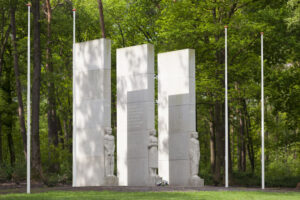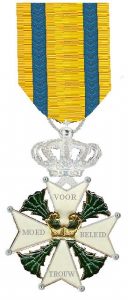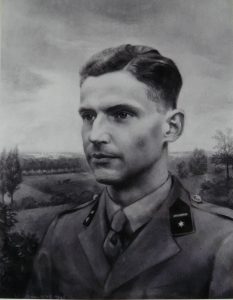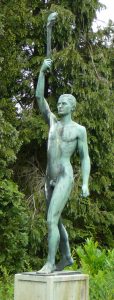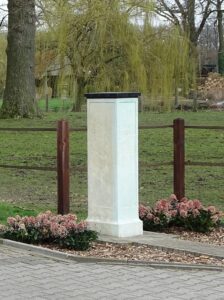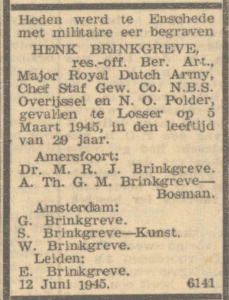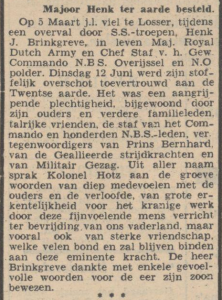- Born 06-06-1915 in Utrecht.
- Died 05-03-1945 in Losser.
- Parents Marius Roelof Johan Brinkgreve, director at Begeers Zilverfabriek, and Antoinette Theodora Geertruida Maria Bosman.
Henk Brinkgreve was around October 1944 three weeks in hiding at the family Juninck ‘Pan‘ in Dulder in the period in which the Twente resistance group from Cor Hilbrink here, after the attack on Huize Lidwina in Zenderen, briefly had his headquarters.
He was cornet at the Artillery and followed the Šróba (School Reserve Officers Mounted Artillery) in Ede in 1933. Afterwards he started his law studies at Leiden. He was a reserve officer in the Dutch armed forces and was mobilized to the German invasion of the Netherlands in 1940. After the German occupation, he fled to England. As an officer of an Allied commando unit, the Small Scale Raiding Force codenamed No. 62 Commando ‘he conducted a successful raid on the lighthouse of Les Casquets. He was in charge of a mission in the Netherlands by a so-called Jedburgh Team Office Special Missions, Dutch oncoming of the Special Operations Executive. Here he was given the temporary rank of reserve Major Weapon of Artillery.
On the night of 11 on September 12, 1944 this Jedburgh team landed, codenamed Dudley, with parachutes at Wierden. The Jedburgh team was next major Henk Brinkgreve (codenamed Dudley) from US Major John Malcolm Olmsted and British Sergeant John Patrick Austin (nicknamed Bunny). From his arrival in Twente Brinkgreve put much energy into the co-operation of Council of Resistance (RVV) and the goons in Twente. He was later even mentioned the practical leader of the opposition in Overijssel. After reaching the very important first target, the formation of a ‘Secret Army’, Brinkgreve and the team Dudley continued with the forming and training of active resistance groups aimed at sabotage.
The farm ‘Pan’ was during World War II, the center of illegal activities, there was a secret transmitter, it was a courier address and were nearby dropped weapons for the resistance.
The farm was a safe place for people who had to keep hidden.
The headquarters and the Jedburgh team had only a short time – from September 24 to October 12, 1944 – accommodated on farm Juninck. As more people came, the farm got too unsafe. That was especially dangerous because the farm also had other people hiding. The headquarters was moved to the farm of Evers ‘Paus’ in Hezingen, a hamlet in Vasse near the German border.
Major Brinkgreve had changed several times of location in the previous period. The Rikhof farm, where he along with two others, was at that time, was to be on 05-03-1945 visited by two S.S.’ers for unknown reasons. Discovery of Major Brinkgreve followed, in which he was shot during a struggle to save the retreat of his friends. He made the often vain motto used by the military Willemsorde true: Courage, Policies, Trouw. It would have cost many lifes of Resistance-people if the data from the staff quarters had fallen into German hands. He was buried initially in Losser.
Buried: Municipal Oosterbegraafplaats in Enschede, No. 27a..
Posthumously awarded to Knight 4th class in the Military Wilhelmsorder, the ‘Kings Commendation for Brave Conduct and the War Remembrance Cross with buckle.
His brother Geurt – sculptor – designed his sepulcher “The Torchbearer. After the statue was stolen in 2010, the pedestal on the Rikhof farm was placed in Losser. In 2013 a new tomb, again was placed made by his brother Geurt. The added portrait of Henk was taken by his brother William – painter.
Plaque Gymnasium in Leiden.
Jedburgh Memorial in the Peterborough Cathedral.
Provincial Resistance Memorial in Markelo and Memeorial in Losser.
In 2014, the book ‘Operatie Jedburgh’ was published about the secret Allied missions in the Netherlands in 1944-1945, written by Jelle Hooiveld.

